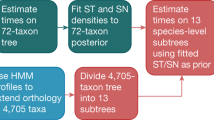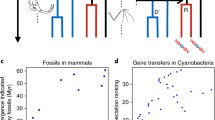Abstract
The timing of whole-genome duplication (WGD) events is crucial to understanding their role in evolution and underpins many hypotheses linking WGD to increased diversity and complexity. As such, means of estimating the timing of the WGD events relative to their macroevolutionary outcomes are of considerable importance. Molecular clock methods facilitate direct estimation of the absolute timing of WGD events, integrating information on the rate of sequence evolution between species while accommodating the uncertainty inherent to the fossil record. We present an explanation of the best practice for constructing fossil calibrations and estimating the age of WGD events via molecular clock methods in the program MCMCtree, with an example dataset based on a well-characterized WGD event within the flowering dogwoods (Cornus). The approach presented herein allows for the estimation of the age of WGD events and subsequent speciation events, allowing the relationship between WGD and the macroevolutionary outcomes to be explored. In our example, we show that in the case of flowering dogwoods, the WGD event long predates the end-Cretaceous mass extinction and that the two events may be independent.
Access this chapter
Tax calculation will be finalised at checkout
Purchases are for personal use only
Similar content being viewed by others
References
Clark JW, Donoghue PC (2018) Whole-genome duplication and plant macroevolution. Trends Plant Sci 23(10):933–945
Zhang Z, Coenen H, Ruelens P, Hazarika RR, Al HT, Oguis GK, Vandeperre A, van Noort V, Geuten K (2018) Resurrected protein interaction networks reveal the innovation potential of ancient whole-genome duplication. Plant Cell 30(11):2741–2760. https://doi.org/10.1105/tpc.18.00409
Barker MS, Li Z, Kidder TI, Reardon CR, Lai Z, Oliveira LO, Scascitelli M, Rieseberg LH (2016) Most Compositae (Asteraceae) are descendants of a paleohexaploid and all share a paleotetraploid ancestor with the Calyceraceae. Am J Bot 103(7):1203–1211
Vanneste K, Sterck L, Myburg AA, Van de Peer Y, Mizrachi E (2015) Horsetails are ancient polyploids: evidence from Equisetum giganteum. Plant Cell 27(6):1567–1578. https://doi.org/10.1105/tpc.15.00157
Landis JB, Soltis DE, Li Z, Marx HE, Barker MS, Tank DC, Soltis PS (2018) Impact of whole-genome duplication events on diversification rates in angiosperms. Am J Bot 105(3):348–363. https://doi.org/10.1002/ajb2.1060
Schranz ME, Mohammadin S, Edger PP (2012) Ancient whole genome duplications, novelty and diversification: the WGD Radiation Lag-Time Model. Curr Opin Plant Biol 15(2):147–153
Dodsworth S, Chase MW, Leitch AR (2016) Is post-polyploidization diploidization the key to the evolutionary success of angiosperms? Bot J Linn Soc 180(1):1–5
Lynch M, Conery JS (2000) The evolutionary fate and consequences of duplicate genes. Science 290(5494):1151–1155
Vanneste K, Van de Peer Y, Maere S (2013) Inference of genome duplications from age distributions revisited. Mol Biol Evol 30(1):177–190
Doyle JJ, Egan AN (2010) Dating the origins of polyploidy events. New Phytol 186(1):73–85
Clark JW, Donoghue PCJ (1858) 2017 Constraining the timing of whole genome duplication in plant evolutionary history. Proc R Soc B Biol Sci 284:20170912. https://doi.org/10.1098/rspb.2017.0912
Macqueen DJ, Johnston IA (2014) A well-constrained estimate for the timing of the salmonid whole genome duplication reveals major decoupling from species diversification. Proc R Soc B Biol Sci 281(1778):20132881. https://doi.org/10.1098/rspb.2013.2881
Yu Y, Xiang Q, Manos PS, Soltis DE, Soltis PS, Song B-H, Cheng S, Liu X, Wong G (2017) Whole-genome duplication and molecular evolution in Cornus L. (Cornaceae) – Insights from transcriptome sequences. PLoS One 12(2):e0171361. https://doi.org/10.1371/journal.pone.0171361
Donoghue PC, Benton MJ (2007) Rocks and clocks: calibrating the Tree of Life using fossils and molecules. Trends Ecol Evol 22(8):424–431
Parham JF, Donoghue PC, Bell CJ, Calway TD, Head JJ, Holroyd PA, Inoue JG, Irmis RB, Joyce WG, Ksepka DT (2012) Best practices for justifying fossil calibrations. Syst Biol 61(2):346–359
Atkinson BA, Martínez C, Crepet WL (2018) Cretaceous asterid evolution: fruits of Eydeia jerseyensis sp. nov. (Cornales) from the upper Turonian of eastern North America. Ann Bot 123(3):451–460. https://doi.org/10.1093/aob/mcy170
Christopher RA (1982) The occurrence of the Complexiopollis-Atlantopollis zone (Palynomorphs) in the Eagle Ford Group (Upper Cretaceous) of Texas. J Paleontol 56:525–541
Doyle JA, Robbins EI (1977) Angiosperm pollen zonation of the continental Cretaceous of the Atlantic Coastal Plain and its application to deep wells in the Salisbury Embayment. Palynology 1:41
Christopher RA (1979) Normapolles and triporate pollen assemblages from the Raritan and Magothy Formations (Upper Cretaceous) of New Jersey. Palynology 3(1):73–121
Gale A, Mutterlose J, Batenburg S, Gradstein F, Agterberg F, Ogg J, Petrizzo M (2020) The Cretaceous period. In: Geologic time scale 2020. Elsevier, pp 1023–1086
Barba-Montoya J, dos Reis M, Schneider H, Donoghue PCJ, Yang Z (2018) Constraining uncertainty in the timescale of angiosperm evolution and the veracity of a Cretaceous Terrestrial Revolution. New Phytol 218(2):819–834. https://doi.org/10.1111/nph.15011
Ho SYW, Phillips MJ (2009) Accounting for calibration uncertainty in phylogenetic estimation of evolutionary divergence times. Syst Biol 58(3):367–380. https://doi.org/10.1093/sysbio/syp035
Benton M, Donoghue P, Asher R (2009) Calibrating and constraining molecular clocks. The Timetree of Life 35:86
Warnock RC, Yang Z, Donoghue PC (2012) Exploring uncertainty in the calibration of the molecular clock. Biol Lett 8(1):156–159
Puttick MN (2019) MCMCtreeR: functions to prepare MCMCtree analyses and visualize posterior ages on trees. Bioinformatics 35(24):5321–5322
Yang Z, Rannala B (2006) Bayesian estimation of species divergence times under a molecular clock using multiple fossil calibrations with soft bounds. Mol Biol Evol 23(1):212–226
Shih PM, Matzke NJ (2013) Primary endosymbiosis events date to the later Proterozoic with cross-calibrated phylogenetic dating of duplicated ATPase proteins. Proc Natl Acad Sci 201305813. https://doi.org/10.1073/pnas.1305813110
Bouckaert R, Vaughan TG, Barido-Sottani J, Duchêne S, Fourment M, Gavryushkina A, Heled J, Jones G, Kühnert D, De Maio N et al (2019) BEAST 2.5: An advanced software platform for Bayesian evolutionary analysis. PLoS Comput Biol 15(4):e1006650. https://doi.org/10.1371/journal.pcbi.1006650
Warnock RC, Parham JF, Joyce WG, Lyson TR, Donoghue PC (2015) Calibration uncertainty in molecular dating analyses: there is no substitute for the prior evaluation of time priors. Proc R Soc B Biol Sci 282(1798):20141013
Yang Z (2007) PAML 4: Phylogenetic analysis by maximum likelihood. Mol Biol Evol 24(8):1586–1591. https://doi.org/10.1093/molbev/msm088
Thorne JL, Kishino H, Painter IS (1998) Estimating the rate of evolution of the rate of molecular evolution. Mol Biol Evol 15(12):1647–1657
Reis MD, Yang Z (2011) Approximate likelihood calculation on a phylogeny for Bayesian estimation of divergence times. Mol Biol Evol 28(7):2161–2172
Jones DT, Taylor WR, Thornton JM (1992) The rapid generation of mutation data matrices from protein sequences. Bioinformatics 8(3):275–282
Rambaut A, Drummond AJ, Xie D, Baele G, Suchard MA (2018) Posterior summarization in Bayesian phylogenetics using Tracer 1.7. Syst Biol 67(5):901
Warnock RCM, Yang Z, Donoghue PCJ (1857) 2017 Testing the molecular clock using mechanistic models of fossil preservation and molecular evolution. Proc R Soc B Biol Sci 284:20170227. https://doi.org/10.1098/rspb.2017.0227
Li Z, Tiley GP, Galuska SR, Reardon CR, Kidder TI, Rundell RJ, Barker MS (2018) Multiple large-scale gene and genome duplications during the evolution of hexapods. Proc Natl Acad Sci 115(18):4713–4718
Nakatani Y, Mc Lysaght A (2019) Macrosynteny analysis shows the absence of ancient whole-genome duplication in lepidopteran insects. Proc Natl Acad Sci 116(6):1816–1818
dos Reis M, Donoghue PCJ, Yang Z (2016) Bayesian molecular clock dating of species divergences in the genomics era. Nat Rev Genet 17(2):71–80. https://doi.org/10.1038/nrg.2015.8
Rothfels CJ, Johnson AK, Hovenkamp PH, Swofford DL, Roskam HC, Fraser-Jenkins CR, Windham MD, Pryer KM Natural History Editor: Mark A.M. 2015 natural hybridization between genera that diverged from each other approximately 60 million years ago. Am Nat 185(3):433–442. https://doi.org/10.1086/679662
Gundappa MK, To T-H, Grønvold L, Martin SAM, Lien S, Geist J, Hazlerigg D, Sandve SR, Macqueen DJ (2021) Genome-wide reconstruction of rediploidization following autopolyploidization across one hundred million years of salmonid evolution. bioRxiv:2021.2006.2005.447185. https://doi.org/10.1101/2021.06.05.447185
Barker MS, Arrigo N, Baniaga AE, Li Z, Levin DA (2016) On the relative abundance of autopolyploids and allopolyploids. New Phytol 210(2):391–398. https://doi.org/10.1111/nph.13698
Spoelhof JP, Soltis PS, Soltis DE (2017) Pure polyploidy: closing the gaps in autopolyploid research. J Syst Evol 55(4):340–352
Doyle JJ, Sherman-Broyles S (2017) Double trouble: taxonomy and definitions of polyploidy. New Phytol 213(2):487–493
Parisod C, Holderegger R, Brochmann C (2010) Evolutionary consequences of autopolyploidy. New Phytol 186(1):5–17
Lohaus R, Van de Peer Y (2016) Of dups and dinos: evolution at the K/Pg boundary. Curr Opin Plant Biol 30:62–69. https://doi.org/10.1016/j.pbi.2016.01.006
Vanneste K, Maere S, Van de Peer Y (2014) Tangled up in two: a burst of genome duplications at the end of the Cretaceous and the consequences for plant evolution. Philos Trans Royal Soc B Biol Sciences 369(1648):20130353. https://doi.org/10.1098/rstb.2013.0353
Levin DA (2020) Did dysploid waves follow the pulses of whole genome duplications? Plant Syst Evol 306(5):1–4
Atkinson BA, Stockey RA, Rothwell GW (2016) Cretaceous origin of dogwoods: an anatomically preserved Cornus (Cornaceae) fruit from the Campanian of Vancouver Island. PeerJ 4:e2808–e2808. https://doi.org/10.7717/peerj.2808
Tank DC, Eastman JM, Pennell MW, Soltis PS, Soltis DE, Hinchliff CE, Brown JW, Sessa EB, Harmon LJ (2015) Nested radiations and the pulse of angiosperm diversification: increased diversification rates often follow whole genome duplications. New Phytol 207(2):454–467. https://doi.org/10.1111/nph.13491
Jiao Y, Wickett NJ, Ayyampalayam S, Chanderbali AS, Landherr L, Ralph PE, Tomsho LP, Hu Y, Liang H, Soltis PS (2011) Ancestral polyploidy in seed plants and angiosperms. Nature 473(7345):97–100
Author information
Authors and Affiliations
Corresponding author
Editor information
Editors and Affiliations
Rights and permissions
Copyright information
© 2023 The Author(s), under exclusive license to Springer Science+Business Media, LLC, part of Springer Nature
About this protocol
Cite this protocol
Clark, J.W., Donoghue, P.C.J. (2023). Constraining Whole-Genome Duplication Events in Geological Time. In: Van de Peer, Y. (eds) Polyploidy. Methods in Molecular Biology, vol 2545. Humana, New York, NY. https://doi.org/10.1007/978-1-0716-2561-3_7
Download citation
DOI: https://doi.org/10.1007/978-1-0716-2561-3_7
Published:
Publisher Name: Humana, New York, NY
Print ISBN: 978-1-0716-2560-6
Online ISBN: 978-1-0716-2561-3
eBook Packages: Springer Protocols




